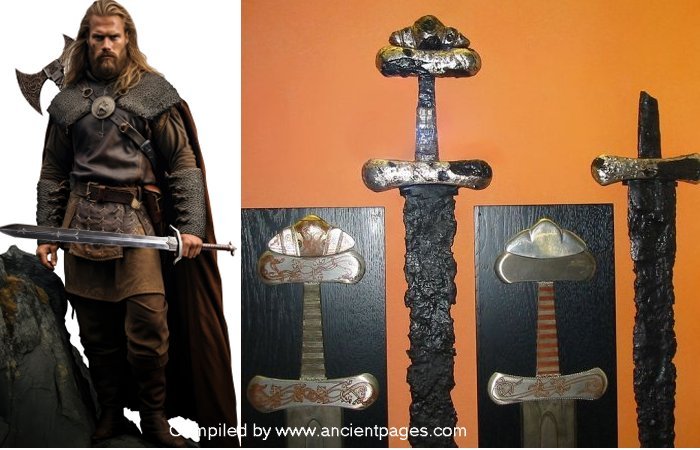Ellen Lloyd – AncientPages.com – Scientists have discovered that Vikings occasionally carried useless decorative swords that could not be used as real weapons.
It seems odd that a Viking warrior would bother to go around with a decorative sword if it could not be used in combat. Were the Vikings vain, or was there another reason why decorative swords became popular?
Left: Viking warrior – Adobe Stock – Ana – Right: Viking swords displayed at Hedeby Viking Museum – Credit: Wikipedia – Image compiled by AncientPages.com
As Ancient Pages wrote earlier, to ancient Vikings a sword was much more than just a weapon. Since swords were difficult to make, they were rare and expensive, and as such, they were not so common and used by kings and Vikings of high rank and class.
Norse Weaponry And Armor
Our information about Norse weaponry and armor during the Viking Age primarily comes from archaeological findings in grave sites and depictions carved on stones. The Sagas and legal texts from later periods also provide insights into how the Norsemen armed themselves for combat.
During the time of the Gulating laws in Norway, Denmark, and Sweden, every able-bodied man needed to own weapons according to his status. In Norway, a sword or ax, spear, and shield were required, while in Sweden and Denmark, each man had to possess a sword, spear, shield, and iron helmet. Furthermore, some laws stipulated that a mail shirt or protective jerkin, a bow, and 24 arrows be provided for each bench seat on a ship or by the local chieftain.
As part of a coming-of-age ceremony, a Norse freeman would receive an armring from his lord, pledging loyalty and service, including the obligation to participate in wars or raids when summoned. Bearing an armring was also a status symbol, and some lords would reward their new subjects with weapons upon swearing oaths.
The use of weapons was an integral part of Norse culture, and from an early age, young boys were trained in their use as part of everyday life. This was a common practice among the different Norse clans.
Vikings believed a man and his sword were bound together. The sword gave power to the warrior, but the warrior’s strength could also be transferred to the sword.
This is also why we often encounter remarkable stories of magical swords in many Norse myths and legends. The Norse people were convinced that some swords were just as powerful as mysterious.
Tyrfying and Gram are two famous magical swords in Norse mythology.
The Norse legend of hero Sigmund and the magical sword in the Branstock tree mentioned in the Sigurdsaga, which is part of the Volsunga Saga (Völsunga Saga), show why swords were believed to have such unusual properties.
Some Viking artifacts remain an unsolved mystery even today. One such example is the Ulfberht Sword. It’s an ancient artifact far ahead of its time, and we do not know whose name is inscribed on this enigmatic ancient sword.
Not long ago, scientists discovered the importance of Vikings’ decorative swords.
Three Viking Age swords were examined. Credit: National Museum of Denmark
A neutron diffraction study conducted on three Viking swords from the National Museum of Denmark revealed that these weapons were created using pattern-welding, a technique in which thin strips of different kinds of iron and steel are welded together and then folded, twisted, and forged in various ways to produce decorative patterns on the resulting surfaces.
All three swords date to the ninth or 10th century A.D. and come from Central Jutland in what is now Denmark.
According to Anna Fedrigo, a materials scientist at the Technical University of Denmark, this was the first study that allowed researchers to virtually ‘slice’ Viking swords, showing how different materials have been combined.
Scientists say Viking swords covered with beautiful decorations became symbols of power and status. They were rarely used because they were never designed for combat. As the role of swords changed in Viking society, these ‘weapons’ simply became decorative clothing accessories.
So, yes, one can say that Vikings were vain, and showing one’s importance in society was common. Vikings also used strong colors as a symbol of status and wealth.
First version of this article was published on December 19, 2017
Written by Ellen Lloyd – AncientPages.com
Copyright © AncientPages.com All rights reserved. This material may not be published, broadcast, rewritten or redistributed in whole or part without the express written permission of AncientPages.com
Expand for references






Recent Comments